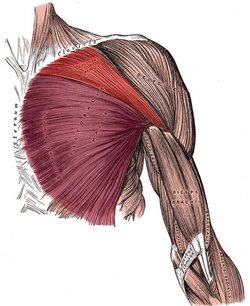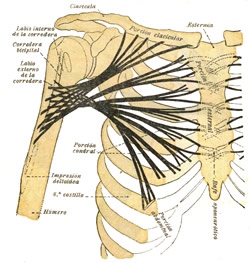
Medical Terminology Daily (MTD) is a blog sponsored by Clinical Anatomy Associates, Inc. as a service to the medical community. We post anatomical, medical or surgical terms, their meaning and usage, as well as biographical notes on anatomists, surgeons, and researchers through the ages. Be warned that some of the images used depict human anatomical specimens.
You are welcome to submit questions and suggestions using our "Contact Us" form. The information on this blog follows the terms on our "Privacy and Security Statement" and cannot be construed as medical guidance or instructions for treatment.
We have 649 guests online
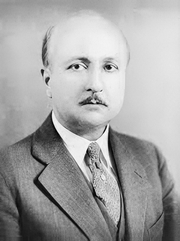
Jean George Bachmann
(1877 – 1959)
French physician–physiologist whose experimental work in the early twentieth century provided the first clear functional description of a preferential interatrial conduction pathway. This structure, eponymically named “Bachmann’s bundle”, plays a central role in normal atrial activation and in the pathophysiology of interatrial block and atrial arrhythmias.
As a young man, Bachmann served as a merchant sailor, crossing the Atlantic multiple times. He emigrated to the United States in 1902 and earned his medical degree at the top of his class from Jefferson Medical College in Philadelphia in 1907. He stayed at this Medical College as a demonstrator and physiologist. In 1910, he joined Emory University in Atlanta. Between 1917 -1918 he served as a medical officer in the US Army. He retired from Emory in 1947 and continued his private medical practice until his death in 1959.
On the personal side, Bachmann was a man of many talents: a polyglot, he was fluent in German, French, Spanish and English. He was a chef in his own right and occasionally worked as a chef in international hotels. In fact, he paid his tuition at Jefferson Medical College, working both as a chef and as a language tutor.
The intrinsic cardiac conduction system was a major focus of cardiovascular research in the late nineteenth and early twentieth centuries. The atrioventricular (AV) node was discovered and described by Sunao Tawara and Karl Albert Aschoff in 1906, and the sinoatrial node by Arthur Keith and Martin Flack in 1907.
While the connections that distribute the electrical impulse from the AV node to the ventricles were known through the works of Wilhelm His Jr, in 1893 and Jan Evangelista Purkinje in 1839, the mechanism by which electrical impulses spread between the atria remained uncertain.
In 1916 Bachmann published a paper titled “The Inter-Auricular Time Interval” in the American Journal of Physiology. Bachmann measured activation times between the right and left atria and demonstrated that interruption of a distinct anterior interatrial muscular band resulted in delayed left atrial activation. He concluded that this band constituted the principal route for rapid interatrial conduction.
Subsequent anatomical and electrophysiological studies confirmed the importance of the structure described by Bachmann, which came to bear his name. Bachmann’s bundle is now recognized as a key determinant of atrial activation patterns, and its dysfunction is associated with interatrial block, atrial fibrillation, and abnormal P-wave morphology. His work remains foundational in both basic cardiac anatomy and clinical electrophysiology.
Sources and references
1. Bachmann G. “The inter-auricular time interval”. Am J Physiol. 1916;41:309–320.
2. Hurst JW. “Profiles in Cardiology: Jean George Bachmann (1877–1959)”. Clin Cardiol. 1987;10:185–187.
3. Lemery R, Guiraudon G, Veinot JP. “Anatomic description of Bachmann’s bundle and its relation to the atrial septum”. Am J Cardiol. 2003;91:148–152.
4. "Remembering the canonical discoverers of the core components of the mammalian cardiac conduction system: Keith and Flack, Aschoff and Tawara, His, and Purkinje" Icilio Cavero and Henry Holzgrefe Advances in Physiology Education 2022 46:4, 549-579.
5. Knol WG, de Vos CB, Crijns HJGM, et al. “The Bachmann bundle and interatrial conduction” Heart Rhythm. 2019;16:127–133.
6. “Iatrogenic biatrial flutter. The role of the Bachmann’s bundle” Constán E.; García F., Linde, A.. Complejo Hospitalario de Jaén, Jaén. Spain
7. Keith A, Flack M. The form and nature of the muscular connections between the primary divisions of the vertebrate heart. J Anat Physiol 41: 172–189, 1907.
"Clinical Anatomy Associates, Inc., and the contributors of "Medical Terminology Daily" wish to thank all individuals who donate their bodies and tissues for the advancement of education and research”.
Click here for more information
- Details
- Written by: Efrain A. Miranda, Ph.D.
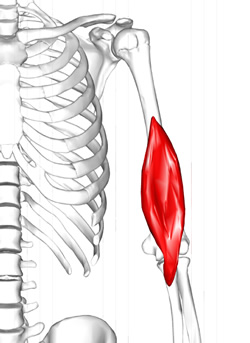
Brachialis muscle.
Click on the image for a larger depiction
UPDATED: The brachialis muscle is a skeletal muscle attached proximally to the anterior surface of the humerus and distally to the coronoid process and tuberosity of the ulna. It is one of the three muscles in the anterior compartment of the arm (flexor compartment), the other two being the biceps brachii and the coracobrachialis.
It is a strong flexor of the elbow found deep to the biceps brachii. Because it does not attach to the radius, the brachialis muscle does not participate in the pronation and supination of the forearm.
The brachialis is supplied by branches of the brachial artery and by the recurrent radial artery.
The innervation of the brachialis muscle is a point to be discussed. Most modern books of anatomy state that this muscle is innervated by the musculocutaneous nerve (C5, C6, and C7). Older and more detailed books state that this muscle has a dual innervation. A 2011 research paper published in Spanish (see Sources #6) describes this dual innervation. The proximal portion of the muscles is indeed innervated by the musculocutaneous nerve, but the distal portion (in 90% of the cases) is innervated by muscular branches that arise off the radial nerve. The radial nerve (C5, C6, C7, C8 & T1) is a branch of the brachial plexus.
Following is an excerpt from the "Trail Guide to the Body" by Andrew Biel: "Ironically, (because it is deep to the biceps) the brachialis girth only helps the biceps brachii to bulge further from the arm, making the brachialis the biceps' "best friend"
Personal note: The research paper that describes the double innervation of the brachialis muscle was done at my alma mater, the University of Chile, and the authors' listing includes two of the contributors to this blog, Professors Claudio Molina and Cristian Uribe. Dr. Miranda
Sources:
1. “Gray’s Anatomy” Henry Gray, 1918
2. "Tratado de Anatomia Humana" Testut et Latarjet 8th Ed. 1931 Salvat Editores, Spain
3. "Gray's Anatomy" 42nd British Ed. Churchill Livingstone 2021
4. “An Illustrated Atlas of the Skeletal Muscles” Bowden, B. 4th Ed. Morton Publishing. 2015
5. "Trail Guide to The Body" 4th. Ed. Biel, A. Books of Discovery. 2010
6. "Doble Innervacion del Musculo Brachial en la Poblacion Chilena" Claudio Molina; Cristián Uribe; Álvaro Heras; Cristián Astorga;Jorge Lemus & Alberto Rodríguez. Int. J. Morphol, 2011. 29(4):1207-1211. A PDF copy of this paper is available here.
Note: The side image modified from the original by Anatomography, CC BY-SA 2.1 JP <https://creativecommons.org/licenses/by-sa/2.1/jp/deed.en>, via Wikimedia Commons following Creative Commons attributes.
- Details
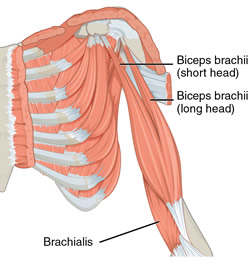
Biceps brachii muscle.
Click on the image for a larger depiction
The musculus biceps brachii is a long muscle found in the anterior, aspect of the arm and is one of the three muscles contained in the anterior compartment (flexor compartment) of the arm, the other two being the brachialis and coracobrachialis muscles. It is composed by two muscular heads, one long (lateral) , and one short (medial) that originate superiorly from separate tendons that attach to the scapula. These two heads join to form a single long, oval-shaped belly with a single tendon that crosses the elbow joint and attaches to the radius.
The short tendon of the biceps brachii passes anteromedial to the shoulder joint and attaches to the coracoid process of the scapula by way of a tendon that mixes with the tendon of the coracobrachialis muscle.
The long cylindrical tendon of the biceps brachii is found in the intertubercular (bicipital) groove (Lat: sulcus intertubercularis) of the humerus, and passes between the greater and lesser tubercles of the humerus, entering the articular cavity of shoulder joint, and continues superiorly to insert in the supraglenoid tubercle of the scapula.
The distal, common tendon of the biceps brachii courses inferiorly and attaches to the radial (bicipital) tuberosity of the radius. There is a well-defined bursa between the radial tuberosity and the biceps brachii tendon that allows for movement of the tendon.
Also, a flat, fascial extension of the tendon, known as the bicipital aponeurosis extends inferomedially to blend with the antebrachial aponeurosis that covers the epitrochlear muscles of the forearm (pronator teres, flexor carpi radialis muscles). The brachial artery passes between the tendon of the biceps brachii and the bicipital aponeurosis in the anterior aspect of the elbow joint.
The biceps brachii crosses both the shoulder and the elbow join. As such, its functions will depend on which joint is fixed and which one is not. This muscle flexes the elbow, supinates the forearm, and flexes the shoulder.
It is innervated by the musculocutaneous nerve (C5,D6) which is a branch of the brachial plexus. It receives arterial supply by way of muscular branches that arise from the brachial artery.
The name of the muscle literally means "two heads" as the prefix "bi" means "two" and the Latin term "-ceps" means "head".
Note: Because the long and the short head of the biceps brachii attach to different locations of the scapula, some authors and Internet websites say that there are 18 muscles that attach to the scapula. I do not agree, as the biceps brachii is a single muscle that happens to have to separate attachments to the scapula. It would be different if this article was titled "Name the 18 separate muscular attachment points of the scapula". Dr. Miranda
The image is modified from the original via Wikimedia. Public domain. Animated image below by Wikimedia Commons - Anatomography [CC BY-SA 2.1 following Creative Commons attributes.
 Sources:
Sources:
1. “Gray’s Anatomy” Henry Gray, 1918
2. "Tratado de Anatomia Humana" Testut et Latarjet 8th Ed. 1931 Salvat Editores, Spain
3. "Gray's Anatomy" 42nd British Ed. Churchill Livingstone 2021
4. “An Illustrated Atlas of the Skeletal Muscles” Bowden, B. 4th Ed. Morton Publishing. 2015
5. "Trail Guide to The Body" 4th. Ed. Biel, A. Books of Discovery. 2010
- Details
- Written by: Efrain A. Miranda, Ph.D.
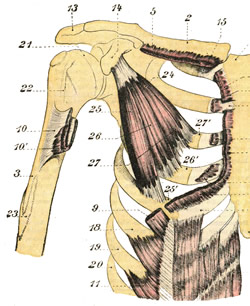
Pectoralis minor muscle (26)
Click on the image for a larger depiction
The pectoralis minor muscle is a small triangular muscle found deep to the pectoralis major in the anterior aspect of the thorax.
This muscle originates from three fleshy bellies that insert into the superior border and anterior surface of the third, fourth and fifth ribs. The muscle fibers converge superolaterally to insert into the inferomedial aspect of the coracoid process, of the scapula, where the tendon of the pectoralis minor intermingles and fuses with the tendon of the coracobrachialis muscle.
The pectoralis minor lies immediately anterior and covers some of the structures of the axillary region, the axillary artery and vein and some of the components of the brachial plexus. In fact, the pectoralis minor muscle is the landmark that divides the axillary artery into its three components: proximal (between the first rib and the medial border of the pectoralis minor). middle (deep to the pectoralis minor), and distal (between the lateral border of the pectoralis major and the inferior border of the teres major muscle). Thus defined the pectoralis major forms part of the anterior wall of the axilla.
In conjunction with other muscles, the pectoralis minor helps to maintain the scapular and shoulder joint in position. If the scapula is fixed, the pectoralis major assists to elevate the anterior thoracic wall during forced inhalation. The pectoralis minor also works as a depressor of the scapula and shoulder joint, abducts the scapula, and rotates the scapula.
The pectoralis minor is innervated by the medial pectoral nerve (C8.T1), a branch of the brachial plexus. Some of the fibers of the medial pectoral nerve perforate the pectoralis minor to provide nerve supply to a portion of the pectoralis major. The pectoralis minor is one of the 17 muscles that attach to the scapula.
Sources:
1. “Gray’s Anatomy” Henry Gray, 1918
2. "Tratado de Anatomia Humana" Testut et Latarjet 8th Ed. 1931 Salvat Editores, Spain
3. "Gray's Anatomy" 42nd British Ed. Churchill Livingstone 2021
4. “An Illustrated Atlas of the Skeletal Muscles” Bowden, B. 4th Ed. Morton Publishing. 2015
5. "Trail Guide to The Body" 4th. Ed. Biel, A. Books of Discovery. 2010
- Details
UPDATED: The pectoralis major muscle is the largest muscle in the anterior aspect of the thorax. It is thick and fan-shaped. It attaches superiorly to the medial 2/3rds of the clavicle, and medially to the anterior aspect of the sternum and cartilages of the first to sixth or seventh ribs, extending inferiorly to attach to the aponeurosis of the external oblique muscle. Laterally, this muscle attaches to the lateral lip of the intertubercular groove (bicipital groove) of the humerus by a two-layered quadrilateral tendon which inserts each of the two heads of the muscle.
The superficial tendon attaches the clavicular head (red in the accompanying image), which extends between the intertubercular groove of the humerus and the clavicle. The deep tendon attaches the sternocostal head (purple in the accompanying image), which extends between the humeral intertubercular groove and the attachments in the sternum, costal cartilages, and the aponeurosis of the external oblique muscle. There is usually a well-defined interval between the two heads of the pectoralis major.
The pectoralis major is innervated by the medial pectoral nerve (C8-T1) and lateral pectoral nerve (C5-C7).
This muscle is covered by the pectoral fascia. An extension of this fascia is the clavipectoral fascia. In both male and female, the mammary gland is situated anterior to and anchors to the pectoral fascia by a number of fascial ligaments known as "Cooper's ligaments"
When both pectoral heads contract as a unit, the muscle adducts. flexes, and medially rotates the shoulder joint and humerus, such as when swimming doing and Australian crawl. Testut & Latarjet (1931) describe three separate muscular segments to this muscle, a clavicular component, a superior sternocostal component, and an inferior sternocostal component. They state that the clavicular components is quite evident, but the other two, although difficult to see, are separate. The clavicular head draws the humerus forward, upward, and medially, such as when you reach for something in front and above you. The sternocostal head draws the humerus down, forward, and medially.
The second image in this article is from Testut & Latarjet (1931) and shows the direction of muscular fibers of the three segments of the pectoralis major.
The word pectoral arises from the Latin term "pectum" meaning "chest, breast". In its true meaning, pectoral or pectoralis refers to a "chest plate" or an "adornment of the chest".
Sources:
1. “Gray’s Anatomy” Henry Gray, 1918
2. "Tratado de Anatomia Humana" Testut et Latarjet 8th Ed. 1931 Salvat Editores, Spain
3. "Gray's Anatomy" 38th British Ed. Churchill Livingstone 1995
4. “An Illustrated Atlas of the Skeletal Muscles” Bowden, B. 4th Ed. Morton Publishing. 2015
First image modified from the original by Henry VanDyke Carter, MD. Public domain. Second image from Testut & Latarjet. Public domain
- Details
- Written by: Efrain A. Miranda, Ph.D.
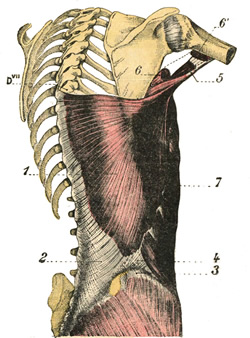
Latissimus dorsi muscle
Click on the image for a larger depiction
The latissimus dorsi muscle is a large, wide, flat muscle on the posteroinferior aspect of the back. It has the shape of a triangle that has a base at the thoracolumbar spine and its apex in the axillary region.
This muscle has a wide origin by tendons that attach to the spinous processes of the lower six or seven thoracic vertebrae as well as those of the lumbar vertebrae, the sacral crest, and the posterior aspect of the external lip of the iliac crest. This created a wide fibrotendinous lamina known as the thoracolumbar fascia. The muscle also attaches to the external surface of the three or four inferiormost ribs and the inferior angle of the scapula.
From here, the muscle fibers converge superolaterally and twist anterosuperiorly to form a quadrilateral tendon that inserts deep into the bicipital groove (Lat: sulcus intertubercularis) of the humerus as shown by number 5 in the accompanying figure. There is sometimes a tendinous extension to the humeral lesser tubercle.
The latissimus dorsi extends, adducts, and medially rotates the shoulder joint, also known as the glenohumeral joint. Along with the teres major muscle they are known as the “handcuff muscles”, as this is the action of these muscles as the hands are brought together towards the back. The latissimus dorsi is innervated by the thoracodorsal (or long subscapular) nerve (C6, C7, and C8).
The Terminologia Anatomica 2 proper name is “musculus latissimus dorsi”. The plural form is “musculi latissimi dorsi”. The name of the muscle is derived from Latin. Since “latum” means “wide”, “musculus latissimus dorsi” means the “widest muscle of the back”, quite a proper name. In other languages this is more evident. In Spanish, the name for the muscle is [músculo dorsal ancho] meaning the “wide muscle of the back”.
The latissimus dorsi is one of the 17 muscles that attach to the scapula. It also forms one of the borders of the lumbar triangle of Petit, potential site for a lumbar hernia.
Sources:
1. “Gray’s Anatomy” Henry Gray, 1918
2. "Tratado de Anatomia Humana" Testut et Latarjet 8th Ed. 1931 Salvat Editores, Spain
3. "Gray's Anatomy" 42nd British Ed. Churchill Livingstone 2021
4. “An Illustrated Atlas of the Skeletal Muscles” Bowden, B. 4th Ed. Morton Publishing. 2015
5. "Trail Guide to The Body" 4th. Ed. Biel, A. Books of Discovery. 2010
- Details
- Written by: Efrain A. Miranda, Ph.D.
- Hits: 43048
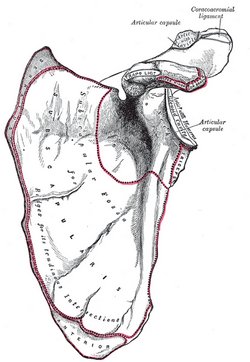
Anterior view of the left scapula.
UPDATED: The scapula is a flat, triangular bone that forms the posterior portion of the shoulder girdle. It is described with two surfaces, three borders, and three angles. The scapula attaches to the clavicle by way of the acromioclavicular joint and ligaments. . Seventeen muscles attach to the scapula and are listed here alphabetically:
1. Biceps brachii
2. Coracobrachialis
3. Deltoid
4. Infraspinatus
5. Latissimus dorsi
6. Levator scapulae
7. Omohyoid (inferior belly)
8. Pectoralis minor
9. Rhomboid major
10. Rhomboid minor
11. Serratus anterior
12. Subscapularis
13. Supraspinatus
14. Teres major
15. Teres minor
16. Trapezius
17. Triceps brachii (long head)
By surfaces, borders, and structures, these muscles group and attach as follows:
Posterior surface:
1. Supraspinatus
2. Infraspinatus
3. Teres major
4. Teres minor
Scapular spine and acromion:
5. Trapezius
6. Deltoid
Anterior surface:
7. Subscapularis
8. Serratus anterior
Medial border:
8. Serratus anterior
9. Rhomboid major
10. Rhomboid minor
11. Levator scapulae
Superior border:
12. Omohyoid (inferior belly)
Medial border:
13. Triceps brachii (long head)
External angle:
14. Biceps brachii (long head)
Coracoid process:
14. Biceps brachii (short head)
15. Coracobrachialis
16. Pectoralis minor
Inferior angle:
17. Latissimus dorsi
Note: Because the long and the short head of the biceps brachii attach to different locations of the scapula, some authors and Internet websites say that there are 18 muscles that attach to the scapula. I do not agree, as the biceps brachii is a single muscle that happens to have two separate attachments to the scapula. It would be different if this article was titled "Name the 18 separate muscular attachment points of the scapula". Dr. Miranda
Sources:
1. "Tratado de Anatomia Humana" Testut et Latarjet 8 Ed. 1931 Salvat Editores, Spain
2. "Gray's Anatomy" 38th British Ed. Churchill Livingstone 1995
Image in the Public Domain, by Henry Vandyke Carter - Gray's Anatomy


